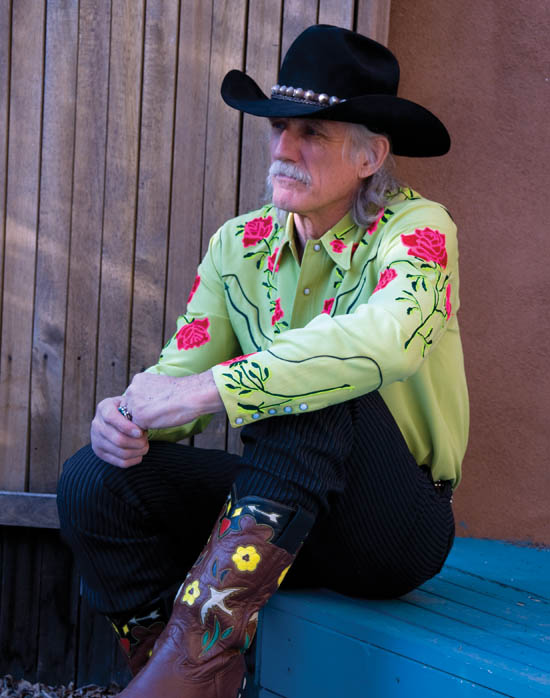Swap a few buttons for snaps and you have a cowboy western shirt. This is what Jack Weil of Rockmount did when he introduced snap-front shirts, not only creating a new style of western shirt but also blazing the trail for a new fashion industry—with H Bar C, California Ranchwear, Ben the Rodeo Tailor, and more following in his path. These became the roots of western wear and western fashion in America. Fashion fades fast, but style sticks forever—and this new western style stuck.



If the shirt fits . . .

. . . Wear It!
For a great selection, and to explore more about the roots of the western shirt, visit rockmount.com. You can even buy a copy of the bible of the western shirt, and the shirt featured on the cover from Rockmount Ranch Wear, the originator of snap shirts. This art deco design, first introduced in the 1950s, is a special numbered edition.


From the era of Buffalo Bill’s Wild West shows through decades of rodeos, country and western performers, and rock ’n’ roll stars, cowboy shirts and western wear have become flashier and fancier.


Lookin’ Snappy
While the bib-front shirt may have been the original cowboy shirt, over time shirt designs went beyond denim into the realms of cotton, gabardine, satin and silk. Rayon gabardine became the material of choice in the 1940s. Designers of western clothing added piped yokes, colorful and detailed embroidery, fringe, sawtooth, fancy cuffs, and, of course, smiley pockets with arrows. In Hollywood, Nudie embellished western shirts with rhinestones to create some of the original rhinestone cowboys, with the exclusive help and flair of Manuel Cuevas, the king of western couture. And Manuel pushed it even farther with more flash, giving style to a beautiful voice. He also put Elvis in a gold lamé rhinestone jumpsuit and made Johnny Cash “the man in black.” And who can forget Dwight Yoakam’s RCA cowboy creased hat, skin-tight pants, and embroidered shirts?

The western-style shirt has been worn from the early 1900s to the present by legendary performers such as Tom Mix, Porter Wagoner, Hank Williams, Roy Rogers, Gene Autry, Elvis Presley, Johnny Cash, Garth Brooks, Marty Stuart, Alan Jackson, Toby Keith, Bonnie Raitt, Mark Chestnutt, Vince Gill, and Yoakam, who are famous not only for their music but for popularizing western wear and taking it to the ultra-fancy level. Even star-powered folks like Jay Leno, Matthew McConaughey, Eric Clapton, and Nicolas Cage caught on to the style.


Roy Rogers. Photo from Singing Cowboys by Douglas Green.

Lasso Up!


Steerin’ some luck
Shirts that cost more than a week’s worth of groceries are like horseshoes that cost more than a horse




You gotta stop & wear the purty flowers
Bolo Ties
A bolo tie is simply a string (often made of braided or twisted leather) for hanging around one’s neck in place of a necktie. The two ends of the string are held together with a bolo, which is an ornamental clip that slides up and down the string to make the look and fit tighter or looser. A bolo tie can be worn with the shirt either buttoned at the top or left open, and women are nearly as likely to wear a bolo tie as a man.
The two ends of the string are tipped in decorative silver or some other material. A Western-style bolo—the slider itself—is often silver and can be designed in any shape the maker imagines—a flower, boot, animal, or star, for example. Bolos are decorated with etching and also cabochons (shaped and polished gemstones). In the West, turquoise is a popular stone for bolo ties.
Both Arizona and New Mexico have named the bolo tie the official state neckwear. So if you don’t have one yet, you’d better pick one out for your wardrobe, along with your boots and hat. Otherwise you risk being branded as a city slicker, and that’s not the cowboy way!



For the real cowboy, whose shirt eventually became a legend, the beginnings were much simpler.
Starting with a simple cotton or wool shirt, worn every day, it had to survive the rigors of a working man.


So he didn’t have to wash or mend his shirt every week, he wore leather cuffs to protect his shirtsleeves and a wild rag to protect his neck from the blazing sun and keep the sweat from dripping down his shirt.
And his wild rag, otherwise known as a scarf or kerchief, was usually silk. It had many other uses. He could use it to keep his neck warm, tie down his hat, or as a washcloth, bandage, water filter, or flag, or just to cover his mouth and nose during a windstorm.

|
A cowboy wears his bandana for the same reason he wears his pants: he ain’t decent without it. |
||
| —Texas Bix Bender, Don’t Squat with Your Spurs On, Vol.2 | ||


Sparkly Sidekick

Avoid flasharity, foofaraw, and fumadiddle
in dress, speech, and conduct.
Leave the Peacocking for the peacocks.
—Texas Bix Bender, Don’t Squat with Your Spurs On, Vol.2
